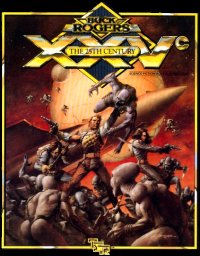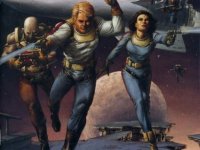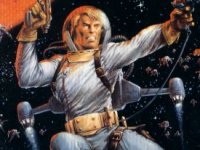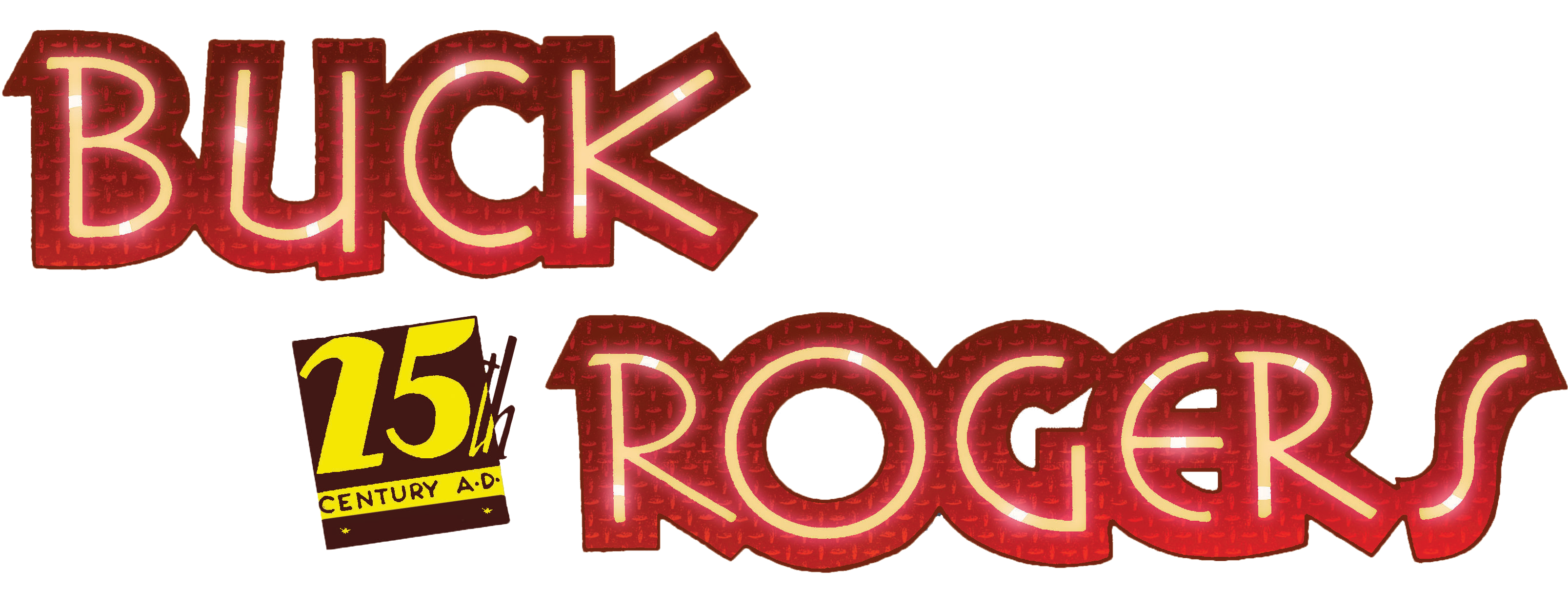 Lorraine Dille Williams, granddaughter of John Flint Dille, "the newspaper syndicate owner who originally conceived of and promoted Buck Rogers", had become the chief executive officer of TSR. Taking advantage of this, her brother Flint Dille wrote a "bible" describing the charter for what was to become the XXVc setting. A TSR team was formed, featuring Mike Cook, Michael Dobson, Jeff Grubb, Jim Ward, Warren Spector, and Jeff Butler. Artists were also called in and a test run of some of the concepts appeared in the Battle for the 25th Century Boardgame. Mike Pondsmith was then brought in for some fresh insite into the timeline and product lists. And thus the game was born.
Lorraine Dille Williams, granddaughter of John Flint Dille, "the newspaper syndicate owner who originally conceived of and promoted Buck Rogers", had become the chief executive officer of TSR. Taking advantage of this, her brother Flint Dille wrote a "bible" describing the charter for what was to become the XXVc setting. A TSR team was formed, featuring Mike Cook, Michael Dobson, Jeff Grubb, Jim Ward, Warren Spector, and Jeff Butler. Artists were also called in and a test run of some of the concepts appeared in the Battle for the 25th Century Boardgame. Mike Pondsmith was then brought in for some fresh insite into the timeline and product lists. And thus the game was born.
 Buck Rogers in the 25th Century® (BR XXVc) is a Sci-fi roleplaying game with a twist; missions have the characters engaging in espionage, sabotage, and other acts of spying. The game is set in a dark future with technology that ranges from 1950's B-movie rockets and microwave guns to advanced genetic engineering and sentient AI programs. The game uses a variation of the AD&D® rules system making it compatible with D&D®, AD&D® (1st & 2nd Editions, only), Boot Hill®, and Gamma World®. It has a better skills system, no weapon proficiencies, and no alignments. The BR XXVc game has a new storyline which for the most part ignores the previous storylines. Buck, Wilma, Kane, and Ardala are all here, albeit in slightly different roles. Dr. Huer is a sentient AI program, RAM has replaced the Han and the Draconian Empire as the "bad guys," and the game is set within our own solar system. BR XXVc was published by TSR in the late 1980's. Unfortunately, the game was poorly marketed and had limited support by TSR (like it predecessor Star Frontiers®). There were only a few articles in TSR's gaming magazines. By the early 1990's the line was discontinued with new releases listed in their latest catalog but never shipped. In all a boxed set, five world reference books, a race book, a hardware book, six missions, 9 or 10 comic modules, and character sheets were produced. Other products included a board game, computer games, ten novels, and another incarnation of the roleplaying game.
Buck Rogers in the 25th Century® (BR XXVc) is a Sci-fi roleplaying game with a twist; missions have the characters engaging in espionage, sabotage, and other acts of spying. The game is set in a dark future with technology that ranges from 1950's B-movie rockets and microwave guns to advanced genetic engineering and sentient AI programs. The game uses a variation of the AD&D® rules system making it compatible with D&D®, AD&D® (1st & 2nd Editions, only), Boot Hill®, and Gamma World®. It has a better skills system, no weapon proficiencies, and no alignments. The BR XXVc game has a new storyline which for the most part ignores the previous storylines. Buck, Wilma, Kane, and Ardala are all here, albeit in slightly different roles. Dr. Huer is a sentient AI program, RAM has replaced the Han and the Draconian Empire as the "bad guys," and the game is set within our own solar system. BR XXVc was published by TSR in the late 1980's. Unfortunately, the game was poorly marketed and had limited support by TSR (like it predecessor Star Frontiers®). There were only a few articles in TSR's gaming magazines. By the early 1990's the line was discontinued with new releases listed in their latest catalog but never shipped. In all a boxed set, five world reference books, a race book, a hardware book, six missions, 9 or 10 comic modules, and character sheets were produced. Other products included a board game, computer games, ten novels, and another incarnation of the roleplaying game.
 The basic plot was that man developed fusion rockets, which allowed exploration of the inner Solar System. Different power groups took different planets: Europe and West Asia grabbed the moon, U.S. and U.S.S.R. hit Mars, African and Asian interests took Venus, and rejects from the rest went to Mercury. Terraforming, made possible by massively successful genetics, was used to make the planets habitable, and the Earth government heavily taxed the colonies.
The basic plot was that man developed fusion rockets, which allowed exploration of the inner Solar System. Different power groups took different planets: Europe and West Asia grabbed the moon, U.S. and U.S.S.R. hit Mars, African and Asian interests took Venus, and rejects from the rest went to Mercury. Terraforming, made possible by massively successful genetics, was used to make the planets habitable, and the Earth government heavily taxed the colonies.
 RAM (the corporate dictatorship that came to govern Mars) eventually turned on Earth and blew it back to the dark ages. Then it proceeded with its long plan of corporate annexation of the other power groups. By the 25th century the power groups include Luna which has come to control most banking and development of old tech, Ishtar of Venus (a culture centered on a religion mixing all old faiths) which sells the drug that allows prolonged exposure to zero-g, and the Sun Kings of Mercury who sell solar energy via microwave beam to the rest of the system. There are many stirrings of revolt: The people who maintain the solar collectors on Mercury don't get much of a cut, Mars is divided into strict castes which give no rights to the poor, and then there are the gennies. Gennies are races of beings that have been genetically engineered to the point their humanity is in question: Mars uses super-strong Workers for slave labor and killing machine Terrines for soldiers, Venus uses the reptilian Lowlanders to farm the drugs, everybody uses the tiny Tinkers to repair technology. A subtext of the materials is the gennies are treated like property, but they are just as human, if not more so, then us. They are starting to form their own cultures and are fed up with the situation.
RAM (the corporate dictatorship that came to govern Mars) eventually turned on Earth and blew it back to the dark ages. Then it proceeded with its long plan of corporate annexation of the other power groups. By the 25th century the power groups include Luna which has come to control most banking and development of old tech, Ishtar of Venus (a culture centered on a religion mixing all old faiths) which sells the drug that allows prolonged exposure to zero-g, and the Sun Kings of Mercury who sell solar energy via microwave beam to the rest of the system. There are many stirrings of revolt: The people who maintain the solar collectors on Mercury don't get much of a cut, Mars is divided into strict castes which give no rights to the poor, and then there are the gennies. Gennies are races of beings that have been genetically engineered to the point their humanity is in question: Mars uses super-strong Workers for slave labor and killing machine Terrines for soldiers, Venus uses the reptilian Lowlanders to farm the drugs, everybody uses the tiny Tinkers to repair technology. A subtext of the materials is the gennies are treated like property, but they are just as human, if not more so, then us. They are starting to form their own cultures and are fed up with the situation.
Into this dark setting with its emphasis on economic slavery, abuse of genetics to create whatever form of life is desired, and computer domination of life comes Buck Rogers, and the player characters.
In conjunction with the role-playing game, TSR briefly published a series of XXVc novels,
as well as a comic book and two computer games. The universe never completely caught on,
and eventually TSR cancelled it. Since then, Buck Rogers has lain dormant — but he still
commands a great deal of public recognition, so another revival can't be ruled out.









